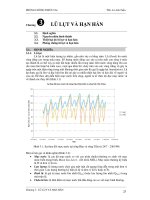DCStradeoff docx
Bạn đang xem bản rút gọn của tài liệu. Xem và tải ngay bản đầy đủ của tài liệu tại đây (307.13 KB, 15 trang )
:
Modulation and Coding Tradeoff and
Digital Communications Design
Goals in designing a DCS
Goals:
Maximizing the transmission bit rate
Minimizing probability of bit error
Minimizing the required power
Minimizing required system bandwidth
Maximizing system utilization
Minimize system complexity
Error probability plane
(example for coherent MPSK and MFSK)
[dB] /
0
NE
b
[dB] /
0
NE
b
Bit error probability
M-PSK
M-FSK
k=1,2
k=3
k=4
k=5
k=5
k=4
k=2
k=1
bandwidth-efficient
power-efficient
Design on the Error probability plane
Bit error probability
M-PSK
M-FSK
k=1,2
k=3
k=4
k=5
k=5
k=4
k=2
k=1
bandwidth-efficient
power-efficient
Selection of parameters
- M in MP vs. MF
- Eb/No for Pb requirement
Limitations in designing a DCS
Limitations:
The Nyquist theoretical minimum bandwidth
requirement
The Shannon-Hartley capacity theorem (and
the Shannon limit)
Government regulations
Technological limitations
Other system requirements (e.g satellite
orbits)
Nyquist minimum bandwidth requirement
The theoretical minimum bandwidth
needed for baseband transmission of R
s
symbols per second is R
s
/2 hertz.
T2
1
T2
1−
T
)( fH
f
t
)/sinc()( Ttth =
1
0
T
T2
T−
T2
−
0
Shannon limit
Channel capacity: The maximum data rate at
which error-free communication over the channel is
performed.
Channel capacity of AWGV channel (Shannon-
Hartley capacity theorem):
][bits/s1log
2
+=
N
S
WC
power noise Average :[Watt]
power signal received Average :]Watt[
Bandwidth :]Hz[
0
WNN
CES
W
b
=
=
Shannon limit …
The Shannon theorem puts a limit on
the transmission data rate, not on the
error probability:
Theoretically possible to transmit
information at any rate , with an
arbitrary small error probability by using a
sufficiently complicated coding scheme
For an information rate , it is not
possible to find a code that can achieve an
arbitrary small error probability.
CR
b
≤
b
R
CR
b
>
Shannon limit …
C/W [bits/s/Hz]
SNR [bits/s/Hz]
Practical region
Unattainable
region
Shannon limit …
There exists a limiting value of below which there can
be no error-free communication at any information rate.
By increasing the bandwidth alone, the capacity can not be
increased to any desired value.
+=
W
C
N
E
W
C
b
0
2
1log
=
=
+=
WNN
CES
N
S
WC
b
0
2
1log
[dB] 6.1693.0
log
1
:get we,0or As
20
−≈=→
→∞→
eN
E
W
C
W
b
0
/ NE
b
Shannon limit
Shannon limit …
[dB] /
0
NE
b
W/C [Hz/bits/s]
Practical region
Unattainable
region
-1.6 [dB]
Bandwidth efficiency plane
R<C
Practical region
R>C
Unattainable region
R/W [bits/s/Hz]
Bandwidth limited
Power limited
R=C
Shannon limit
MPSK
MQAM
MFSK
5
10
−
=
B
P
M=2
M=4
M=8
M=16
M=64
M=256
M=2M=4
M=8
M=16
[dB] /
0
NE
b
Power and bandwidth limited systems
Two major communication resources:
Transmit power and channel bandwidth
In many communication systems, one of
these resources is more precious than the
other. Hence, systems can be classified as:
Power-limited systems:
save power at the expense of bandwidth (for example by
using coding schemes)
Bandwidth-limited systems:
save bandwidth at the expense of power (for example by
using spectrally efficient modulation schemes)
M-ary signaling
Bandwidth efficiency:
Assuming Nyquist (ideal rectangular) filtering at baseband,
the required passband bandwidth is:
M-PSK and M-QAM (bandwidth-limited systems)
Bandwidth efficiency increases as M increases.
MFSK (power-limited systems)
Bandwidth efficiency decreases as M increases.
][bits/s/Hz
1log
2
bs
b
WTWT
M
W
R
==
[Hz] /1
ss
RTW ==
][bits/s/Hz log/
2
MWR
b
=
][bits/s/Hz /log/
2
MMWR
b
=
Design example of uncoded systems
Design goals:
1. The bit error probability at the modulator output must meet the
system error requirement.
2. The transmission bandwidth must not exceed the available
channel bandwidth.
M-ary
modulator
M-ary
demodulator
][symbols/s
log
2
M
R
R
s
=
[bits/s] R
s
sb
r
R
N
E
R
N
E
N
P
000
==
[ ]
)( ,)(
0
MPgP
N
E
fMP
EB
s
E
=
=
Input
Output









